International Exchange - (2011) Volume 19, Issue 6
Department of Family Medicine, Ghent University, Belgium
Pim De Graaf MD MPH*
European Forum for Primary Care, Almere, The Netherlands
On behalf of the Position Paper Working Group: Aggie Paulus, Arno Van Raak, Peter Groenewegen (The Netherlands), Carmen de la Cuesta (Spain), Danica Rotar (Slovenia), Hanna Kaduskiewicz, Martina Hasseler, Ulrike Junius Walker (Germany), Isabelle Vedel (Canada), Jan De Lepeleire, Janneke Ronse, Jean-Pierre Baeyens (Belgium), Modesta Visca (Italy), Steve Illife (UK)
Received date: 18 August 2011; Accepted date: 16 October 2011.
This article explores how to address the needs of the growing number of older patients in primary care practice. Primary care is not a fixed organizational structure but a combination of functional characteristics which has developed variably in European countries with differing responses to the emerging needs of older persons. Multimorbidity, frailty, disability and dependence play out differently in older persons; a key challenge for primary care is to provide a response that is adapted to the needs of individuals – as they see them and not as the professional defines them. Indeed, growing experience shows how to involve older persons in taking decisions. Contrary to popular opinion, older persons often rate their quality of life as high. Indeed, comprehensive primary care offers health promotion and prevention: also older people may benefit from measures that support their health and independence and some case descriptions show this potential. Although most people prefer to be in their own environment (home, community) during the last stage of life, providing end-of-life care in the community is a challenge for primary care because it requires continuity and coordination with specialist care. Successful models of care however do exist. Delivering seamless integrated care to older persons is a central theme in primary care. Rather than disease management, in primary care, case management is the preferred approach. Proactive geriatric assessment of individual medical, functional and social needs, including loneliness and isolation, has been shown to be useful and its place in primary care is the subject of further research. Clinical practice guidelines for multimorbidity are badly needed. Non-adherence to medication, linked to multiple and uncoordinated prescriptions, is a widespread and costly problem. Successful approaches in primary care are being developed, including the use of electronic patient files. With the general practitioner (GP) as the central care provider, primary care is increasingly teamwork, and the role of nurses and other (new) professions in primary care is developing constantly. The composition and coordination of teams are two components of one of the major complexities to address: how to provide individualised care with standardisation at organisation the level. (Lack of) Coordination with specialist care remains a widespread problem and needs attention from policy makers and practitioners alike. Alignment with home care and social services remains a challenge in all countries, not least because of the different funding arrangements between the services. Further priorities for research and development are summarised.
health services research, integrated care, international exchange, older persons, pri-mary health care
The year 2012 will be the European Year of Healthy Ageing. Improving and reorganising care for older persons in modern health systems has become a priority.[1] Current European Union policy on ageing is dedicated to maintaining the social inclusion of older people through three main themes: prevention, equity of access and an adequate supply of quality care.[2]
Intended as an inspiration to policy makers, prac-titioners and researchers across Europe, this Position Paper examines the response by primary care to the health needs of increasing numbers of old persons in European countries, and the challenges ahead.
Primary care is not a fixed organisational structure or level of care that can be easily and unambiguously identified. Instead, it is considered to be a combi-nation of essential characteristics:
• care that is easily accessible in the community, without financial or physical (distance) barriers
• person-oriented care rather than disease- or organ-oriented care. This implies attention to the function-ing and autonomy of people and requires continuity of care
• comprehensive and quality care, implying evidence-based generalist care for all common health prob-lems. It includes collaboration with specialist services where generalist services are insufficient
• care that takes responsibility for the health of people in the community, which implies attention to the determinants of ill-health and social aspects, and a strong interaction with public health and social services
• care that sees people as decision takers and active partners in managing their own health.
Key characteristics for strong primary care have been defined:[3] Strong primary care provides a generalist approach, is the first point of contact with health care, is oriented to both context and community, provides continuity and comprehensiveness in terms of health issues (including prevention and promotion, care and cure) and diseases, and ensures coordination. Although some consider that the simplest single indicator of strong primary care is whether the country has a system of gatekeeping GPs,othersargue that the elements ofstrong primary care as listed above can be realised without a system of obligatory gatekeeping GPs. Currently, sophis-ticated tools for the assessment of primary care in European countries are being developed providing a more nuanced picture of the degree of development and strength of primary care.[4] Of late, there is em-phasis on the role of the GP as navigator through the health system with and for the patient.
Reform of health care and primary care is ongoing in many countries. All countries struggle to provide adequate financial and human resources to the health sector while achieving acceptable coverage and quality of care. Comparing or addressing approaches to health-care Funding are outside the scope of this article. How-ever, according to the World Health Report of 2008[5] most countries would benefit from four major reforms:
1 universal coverage reforms, to improve health equity
2 service delivery reforms, to make health systems people-centred and of high medical quality
3 leadership reforms, to ensure the development of coherent health systems
4 public policy reforms, to promote the collaboration between public health and primary care, addressing the health of communities as well as individuals.
While convergence takes place in the role and func-tions of primary care, the organisation, structure and Funding base varies widely between countries.[6–8] Some countries have developed a strong and coherent pri-mary care system, whereas others are less oriented towards the community and more to hospitals. No country, however, can claim to have a primary care system that is sufficiently robust to adequately address all the challenges it meets – including the provision of quality care for older persons.
This article is one of a series of Position Papers of the European Forum for Primary Care (EFPC) and has been developed in 2010 and 2011 according to standard procedures.[9] A Medline search on primary health care and health services for the aged (January 2004 to April 2011) provided a scientific basis and guided the expert consultation process.[9] Two work-shops supported input and discussion by experts at two conferences in 2010.[10,11] A considerable amount of grey literature has contributed to this article.
The name Position Paper refers to positioning of primary care rather than to the position of the EFPC. This article does not claim encyclopaedic complete-ness, it aims to show variety and highlights. Because of the diversity between countries, specific examples need (national) context to provide understanding about the critical factors for success or failure in a particular setting.
Obviously, there is a large overlap between provid-ing care for older persons and care for persons with a chronic disease and long-term care. This artcle focuses specifically on older persons. Chronic disease and long-term care are the subject of other Position Papers of the EFPC.
In this article, we limit primary care to care that is provided by health professionals – delineating primary care from general social (support) services. However, integrated care by strong collaboration between pri-mary care and social services is one of the main themes of this article.
Profiles of ageing, health of older populations and of older persons: the individual experience
Increasing proportions of older persons in our societies ...
In Europe, the proportion of people aged 65 years and older is projected to grow from just under 15% in 2000 to 23.5% by 2030, whereas the proportion of those aged 80 years and over is expected to more than double, from 3% in 2000 to 6.4% in 2030.[12] However, the pace of ageing in Europe differs considerably between countries. Currently, Turkey and Ireland have the lowest proportion of people over 65 years of age (6 and 11%, respectively), whereas Germany, Austria and Italy have the highest proportion ( 20%).[13] In all countries, these percentages are higher for females than for males and they are increasing. As a result of increasing longevity, currently, at the age of 65, females have a life expectancy of 15 (Turkey) to 22 (Spain) years. For males, these figures are 13 (Slovak Republic and Hungary) and 18 (Switzerland) years.[14] In 2050, Spain will be the country with the highest proportion of older persons in the world: 30%.[15]
... and how that will work out in terms of morbidity
While the numbers of old and very old people in-crease, the future health profile of the ageing European population is not yet clear. Some expect that the increase in longevity will result in compression of morbidity: as populations adopt healthier lifestyles and therapeutic advances continue, the period of illness that individ-uals experience before death is getting shorter.[16–18] Others observe and expect a shift of morbidity to higher age groups,[19] without clear compression:morbidity starts later and lasts as long as it did in previous decades. In all cases, the mid-term perspective is an increase in long-term conditions and chronic diseases, including a high prevalence of multimorbidity.[20,21] In patients aged over 65 years, the latter varies between 50 and
80%.[22] For people aged over 80 years, a prevalence of over 70% has been reported [22,23] resulting in patients with multimorbidity being the rule rather than the exception within primary care.[24,25]
Shifting morbidity leads to shift in needs for care
Many previously chronic diseases can now be treated with quick and good results: impaired vision because of cataract is treated with the lens implant, hip and knee replacements restore mobility, angina pectoris can be treated with stenting, the latter transforming an acute illness with premature deaths into a chronic condition. By contrast to these achievements, the prevalence of other chronic diseases such as diabetes, depression, dementia, Parkinson’s disease, cardiovascular disease, chronic obstructive pulmonary disease (COPD) and stroke is rising. Some diseases are more or less typical for older people, for example, dementia (90– 95% of all cases above age 65 years) and other diseases have a higher prevalence in the older population: malignancies with 85% occurring above age 50 and 40% above age 70 or Parkinson’s disease with 75% of cases above age 60. In some population groups, unhealthy lifestyles, genetic and context factors may lead to an early start of chronic disease such as COPD and diabetes, leading to a very long period with chronic illness.
Multimorbidity is a complex phenomenon with an almost endless number of possible disease combi-nations with a large variety of implications. In general, multimorbidity is associated with poor quality of life, physical disability, high healthcare utilisation, hospi-talisation and high healthcare costs and mortality.[26] However, despite multimorbidity, older people do not necessarily rate their quality of life as low.[27]
There is more than morbidity: frailty and disability also come with age ...
Approximately 17% of patients older than 65 years are frail, with higher proportions in southern than in northern Europe. Very frail people aged 80 years and over are major users of informal care and health and social services.[28,29] Frailty leads to a higher risk of falls, loss of mobility, functional decline, recurrent hospi-talisation, institutionalisation[30,31] and death,[30–35] and is relatedto lower life satisfaction (see Box 1).[36] Frailty can be conceived as a pre-disability state, disability being an umbrella term, covering impairments, activity limitations and participation restrictions, at the level of the individual.[37] The interpretation of functional status and disability varies across countries, cultures, financing systems, (health) professionals and individ-uals. A standardised definition of disability in clinical practice would be needed to compare therapeutic and supportive approaches. The International Classification of Functioning and disability in health (ICF) should be explored in this respect.
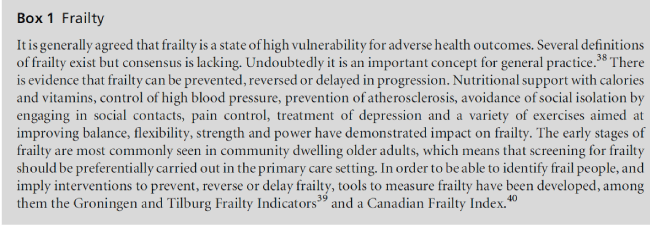
Box 1: Frailty
... and loneliness and social isolation
Loneliness is a subjective negative experience, whereas social isolation is the objective condition of not having ties with others.[41,42] Desperate need for contact might
lead to (exacerbation of) physical complaints and provokes the use of health services. Loneliness and social isolation have been related to depression, higher blood pressure, worse sleep, immune stress responses and worse cognition over time.[43] Indeed, on average, older persons without a partner have worse physical and psychological health than persons with a partner. In the UK, living alone in later life is seen as a potential health risk being independently associated with mul-tiple falls, functional impairment, poor diet, smoking, the risk of social isolation and some reported chronic conditions.[44] Social networks including a spouse and larger networks of close relatives and friends mitigate the influence of depressive symptoms.[45] In surveys carried out among the general public, loneliness and social isolation are often mentioned as a serious prob-lem for older adults. Loneliness is especially a problem of the very old: of those aged 80 and over, 40–50% report they are often lonely.[41] In central and northern European countries, family links are weaker, whereas in Mediterranean countries stronger family ties are more prevalent. These differences are reflected by higher levels of institutionalisation and solitary living in coun-tries with an individualistic tradition. However, reported loneliness varies widely within countries and, para-doxically, in general, southern European countries show a high prevalence of reported loneliness, while it is less common in western and northern Europe.[41]
Multimorbidity, frailty and disability lead to dependence ...
The relationship between frailty, disability and (multi)-morbidity is poorly understood and although there is some overlap between the concepts, they should be distinguished (Figure 1).[46] Each of the concepts confers specific care needs in older patients and the complexity of healthcare needs and necessity for coordination of care among multiple providers and services increases with the number of these conditions present. In various European countries, the proportion of older persons that needs assistance is high and increasing: German figures for instance demonstrated an increase of 29% from 1991 to 2002 with 30% of those aged 85+ in need of help with basic activities of daily living. However, the HALE project concludes that, although European populations are ageing, the proportions of older people with a disability are decreasing. This suggests that the dynamics of functioning may differ across cultures.[47]
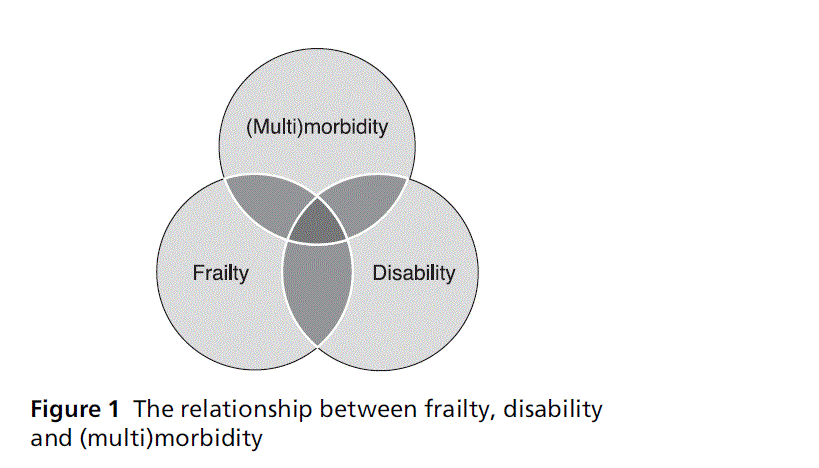
Figure 1: The relationship between frailty, disability and (multi)morbidity
Specific population groups with specific needs
Finally, health, illness and survival are not distributed equally across all population groups. Socio-economic differences are demonstrated for the prevalence of diseases, the stages of disease at diagnosis[48–53] and the chances of survival,[54–58] which are higher for patients from higher socio-economic groups. Regardless of country, research methods or instruments used, in all social layers, people have a lower life expectancy than those in the layer above. Also, the higher the position in the social hierarchy, the lower the risk of ill-health and premature death.[59] These differences indeed sometimes translate into disadvantaged elderly making more use of secondary care.[60]
Ageing is an individual experience
The previous paragraphs highlight the different health and life problems experienced at old age, but the life perspective of older persons themselves actually is not at all negative. Ageing also brings positive gains in terms of wisdom, strategic thinking and social respon-sibility. Also, older people themselves are important providers of care to others.
Older persons do not rate their quality of life (QOL) lower than young persons (Figure 2) and the re-duction of QOL in persons with chronic diseases like dementia is far less apparent than often assumed.[61] Higher levels of well-being of individuals are asso-ciated with an extra 7–10 years of life, compared with those with lower levels of well-being. Happiness may alter perceptions of need for health care at the indi-vidual level – older people with higher life satisfaction may not seek medical help as readily as their less satisfied peers.[62] Surprisingly, at the population level, well-being is inversely associated with longevity over time and across countries. As people in European countries be-come happier, they become relatively less healthy in the medium term. Well-being during life follows a U-shaped distribution, with ill-being greatest in mid-life.[63] There is increasing evidence from both the USA and Europe that ‘merry life’ in middle age (smoking, drinking, overweight, cardiovascular risk factors) leads to unhappy late life and poorer QOL old age (if one reaches that far). Selection may be contributing: un-happier persons with unhealthy habits have died before reaching old age. However, high levels of well-being in later life may not only be associated with healthy behaviour but also with consumption (eat, drink and be merry!). Old people with healthy habits may be even happier. All in all, ‘shorter but merrier’ life may be a myth.
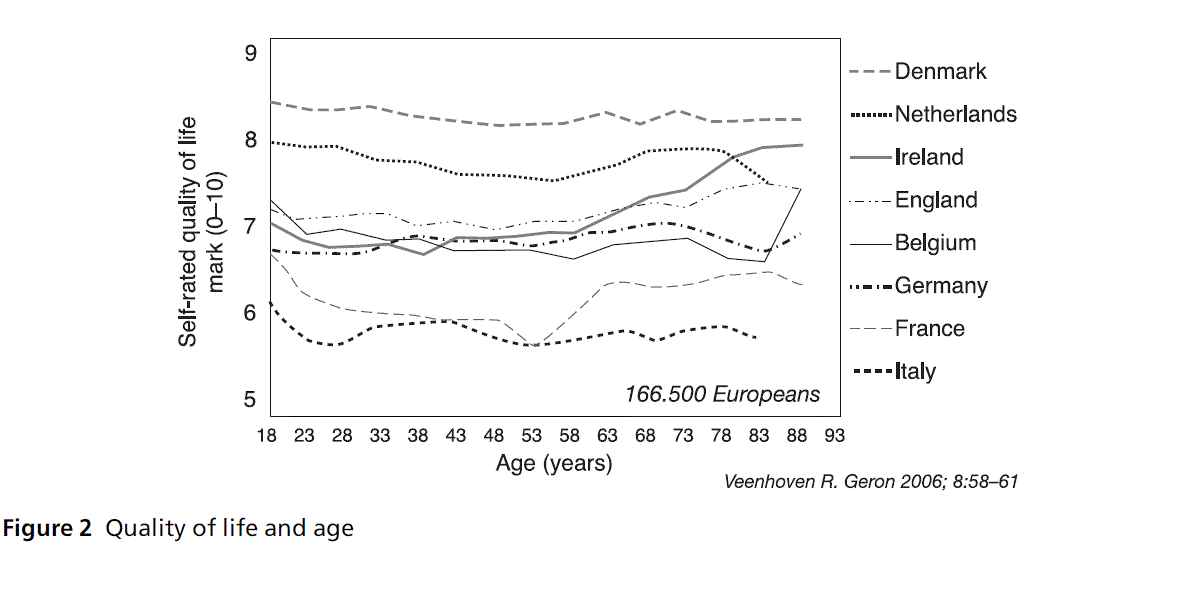
Figure 2: Quality of life and age
The introduction, some years ago, of the concept of successful ageing voiced a change in thinking about ‘age-related’ decline. It marked the awareness that functional loss and dependency cannot simply be seen as consequences of the ageing process itself when disease is absent. Many clinicians still do not fully appreciate that loss of function in later life (difficulties with walking, balance, memory or conti-nence) are due to illness, and detection of functional loss is generally poor. Frailty and disability should be considered as dynamic and also potentially reversible processes.
In spite of (multi)morbidity, frailty and disability, older persons often enjoy a high QOL. The increasing number and proportions of older persons call for a rethink of the services that our health systems deliver and the way these systems are organised. This includes a challenge for primary care. Older people are as much
– or more – a heterogeneous group as persons from any other age group. Primary care needs to shape itself in such a manner that it is possible to give an indi-vidualised response to older persons, taking into account their specific needs and wishes.
Primary care for older patients, what services to offer?
There is remarkable similarity between countries in shortcomings in care for older persons. The obser-vations made in France, are valid for many countries (see Box 2).
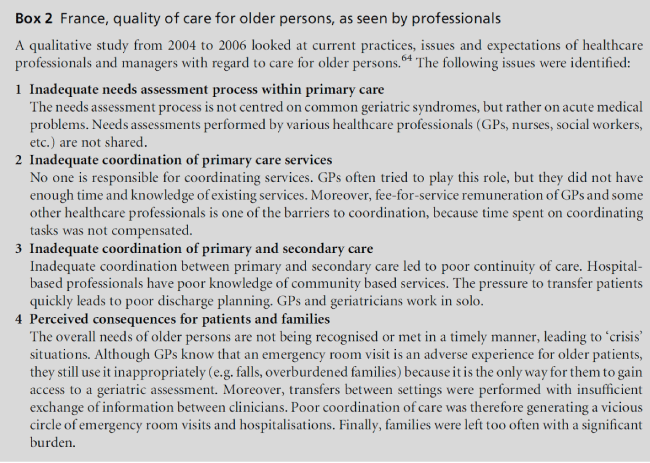
Box 2: France, quality of care for older persons, as seen by professionals
Well-developed primary care has the potential to address the health needs of older people appropriately, because it is person-oriented, community based and comprehensive. To some extent, primary care, home care and institutional care, like nursing homes, are communicating vessels. However, large differences between countries do exist in the amount of formal care of either kind that persons aged over 65 receive (Figure 3).
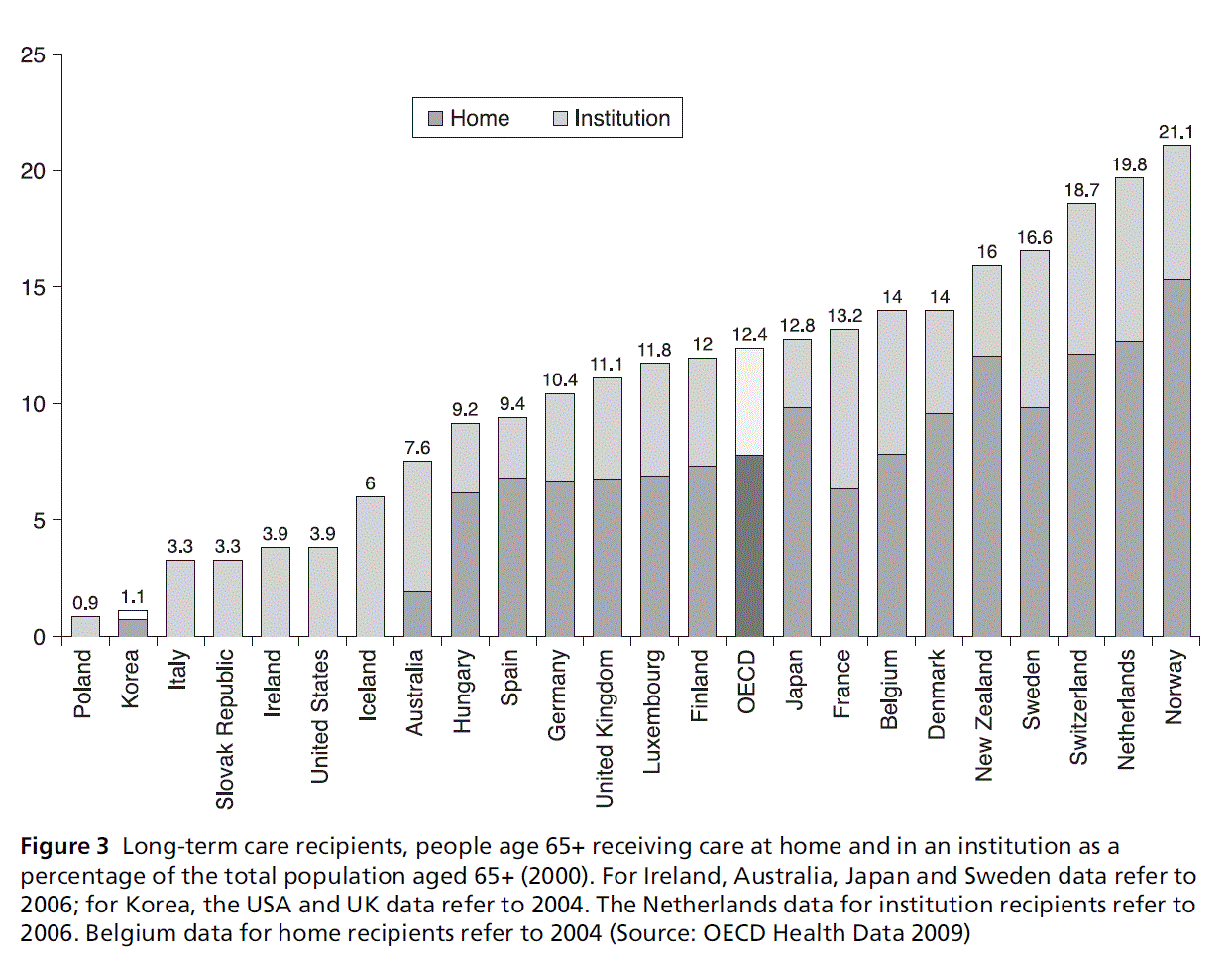
Figure 3: Long-term care recipients, people age 65+ receiving care at home and in an institution as a percentage of the total population aged 65+ (2000). For Ireland, Australia, Japan and Sweden data refer to 2006; for Korea, the USA and UK data refer to 2004. The Netherlands data for institution recipients refer to 2006. Belgium data for home recipients refer to 2004 (Source: OECD Health Data 2009)
Below, we review the specific challenges for and functions and interactions of primary care, and we assess in how far it fulfils its role in daily practice. As mentioned in the introduction, this article does not discuss Funding of primary care for older persons in detail. However, the way in which primary care might respond to the challenges it meets depends largely on the way resources are allocated. In general, current healthcare systems are largely built on an acute epi-sodic model of care which is ill equipped to meet the long-term and fluctuating needs of older people with complex chronic health problems. In addition, health and social services are mostly funded from different sources and the integration of service delivery is often as much a matter of smoothing out different Funding principles and arrangements as developing integrated care concepts and professional collaboration. In virtually all countries, historical Funding arrangements are an obstacle to integrated, client-oriented care,[65] with an important mismatch between the needs of the popu-lation for proactive, integrated and preventive care for chronic conditions and a healthcare system in which the balance of resources is aimed at specialised epi-sodic care for acute conditions.
Person-oriented care: the challenge to respond to needs of older people as they see them
In most countries, primary care practitioners see their patients in their own environment, over a long period, with an understanding for the medical and non-medical life history of their patients and with the capacity to discuss the approach to their general situation and health. The practitioner has the possibility to assess how the combination of frailty and physical dependence with co-morbidity and social isolation – or the absence of these – work out in a particular patient. Organ- or disease-oriented specialists do not have that luxury: mostly they see a fraction of the reality of the patient – often in the short period a clinical consultation allows for.
GPs are in a unique position to identify perceived needs and loneliness because they are in contact with very old people, bereaved people and people with disabilities – the three groups most at risk. They have the responsibility to offer individually tailored initiat-ives with the patients to ease their distress of disease, disability and loneliness.
However, also in primary care practice, the experi-ences and perspectives of older people themselves may not be the same as those identified by professionals.
Patients and doctors do not intuitively agree on the importance of individual health problems.[29,66–69] The following themes emerged from several studies con-ducted in different primary care settings in the UK,[67,68] USA[66] and Sweden.[29,69] Patients describe ideal care as patient-centred and individualised with convenient access to providers (telephone, internet, in person); clear communication of individualised care plans; support from a single coordinator of care who can help patients prioritise the competing demands from their multiple conditions (see Box 3); and continuity of relationships. Many patients express a great appre-ciation of services even if they have limited expectations of improvement in their health status that those services could bring about.[66] Patients especially value face-to- face, personalised and flexible appointments. Under-utilisation of services by older persons occurs regularly and is explained by three thresholds: (1) the services offered do not address their needs, (2) their own frailties limit access to or use of the services, and (3) there is a lack of service flexibility. This latter point deserves emphasis: people want the timing and type of care to be tailored and coordinated with their indi-vidual circumstances. Very old people with a perspective of further frailty and dependence often perceive the home as the last area over which they are able to assert control and retaining that control is a priority for many.

Box 3: Consultations in German general practice
Even more than in other parts of the health system, in primary care the challenge is to provide care that is patient or client-oriented and individualised, but that is also standardised – in order to streamline the pro-vider organisation, so as to avoid time-consuming activities that do not directly benefit the patient. In recent years, the concept of modularity has been developed and tested in primary care.[70] It is a prom-ising tool but not yet ready for use for planning and organisation of services.
Person-oriented care: the challenge to involve older persons in taking decisions – self-empowerment
Over the last 30 years, an important paradigm shift in health care has taken place: autonomy and decision taking by patients have replaced the earlier obedient and passive patient role. Nowadays, optimal care means patient involvement and empowerment, including being informed about every stage in the care process. Indeed,
patients’ influence in the decision-making process is greatly appreciated.[66,71] There are several ways to involve patients in priority setting, even in cases of low health literacy. A Slovenian survey showed that the use of simple paper tools by older patients can increase their participation in the setting of priorities and defining treatment.[72]
Comprehensive care: providing prevention and health promotion
Prevention and health promotion for older people are considered an important task for primary health care because they represent the first port of call for patients and a regular contact. There is no justification for neglecting this task due to a pessimistic approach to ageing and older patients. Health promotion inter-ventions in later life require a different focus than those at younger ages, with an emphasis on reducing age-associated morbidity and disability and the effects of multimorbidity. Preventing falls in primary care has been shown to be effective[76] and primary care often emphasises prevention through ‘preventing falls pro-grammes’ by weight-bearing exercise or ‘preventative home visits’. Physical activity as a whole is one of the most important factors alleviating the age-related decline.[77] Some evidence shows that older persons prefer messages that focus on health and indepen-dence, rather than on falls and injuries, and that value independence, sense of individuality, self-esteem and freedom to decide what activities to undertake. A broader approach of prevention and health promotion for older persons within primary care may be useful in developing strategies that assist older persons to maximise their autonomy, QOL and independence. Even a small reduction in disability may translate into large healthcare savings and improvements in the physical, emotional and social health of older persons. Prevention and health promotion for older persons equally requires their own active role. This can be achieved through low-threshold services and multi-disciplinary assessment and programmes. The pro-grammes should include medical as well as nursing and activating or rehabilitative services.
Comprehensive care: addressing (multi)morbidity in older persons
The development and use of clinical practice guide-lines in primary care is a major achievement of evidence-based medicine of the last 20 years. In most countries in Europe, this has lead to the development of disease-specific management programmes (see Box 4). Within those developments, old age psychiatry has been largely underdeveloped although some mental diseases have a growing prevalence and a high impact on QOL of both patients and their environment.
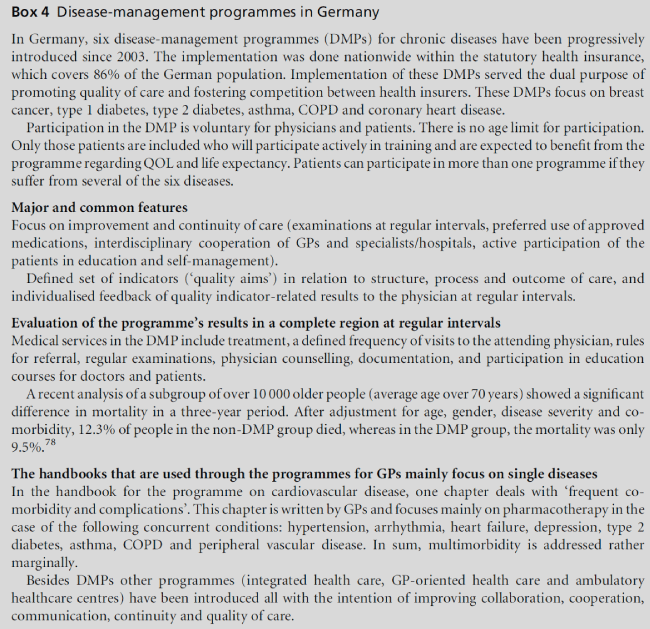
Box 4: Disease-management programmes in Germany
Being disease specific in set up, DMPs and disease-specific evidence-based guidelines have limitations when used in persons with multimorbidity.[25,79–81]
For example, recommending exercise to improve the health of a person with diabetes or COPD may be inappropriate if osteoarthritis limits movements due to pain or if lack of motivation is caused by depression. Multiple providers also lead to fragmentation of care,
competing or conflicting guidelines and inattention to the pReferences and concerns of the older patient.[79,82]
It is clear that managing multimorbidity, is much more than simply the sum of separate guidelines.[25]
As may be expected, older persons use more medi-cines than the younger population. In the Dutch population aged below 65 years, 38.5% use a prescrip-tion drug. In the population aged above 65 years, this is 80%. The older general practice population in Germany is among the top as users of pharmaceuticals in European study samples. The proportion of older people in the UK who take several medicines – polypharmacy – is high and increasing over time: according to recent studies up to 40% of the older population uses at least five medicines and 12% uses ten or more.
Older patients are subject to specific risk factors for non-adherence and failure to adhere to medication among older people is a widespread and costly prob-lem.[83] It has been estimated that up to 50% of cardio-vascular disease admissions may be due to poor adherence. More than 19 000 patients are hospitalised per year, as a result of potentially avoidable medi-cation-related problems. Not age per se, but poly-pharmacy and multimorbidity, are strong risk factors for inappropriate medication. Because older people often suffer from more than one chronic condition they tend to take more medicines than their younger counterparts. Apart from disease-specific determi-nants, GPs should be aware that low subjective health and medication disagreement are independent pre-dictors of polypharmacy.
The use of potentially inappropriate medicine (PIM), including prescribed medicines, is a well-known phenomenon and the side effects of drugs are often interpreted as general age-associated symptoms (e.g. dizziness, cognitive impairment and somnolence). Sev-eral European countries (France, Ireland and Germany) have published lists of inappropriate medications to be avoided in the older population, however, a Euro-pean perspective is lacking. A European consensus on the indication for antipsychotic drugs is yet to be developed. Co-morbidity may lead to difficult choices. For example, corticosteroids may be prescribed for treatment of COPD, but adversely affect the patient who has diabetes as well. This is an example where the final treatment decision needs to be taken in close consultation between prescriber and patient.
Further factors affecting adherence are the follow-ing: older patients are more likely to face problems of memory and of understanding regimens and instruc-tions; problems with visual acuity (e.g. reading the information leaflet or the mode of use on the label) and dexterity (e.g. opening the vial of a bottle or pushing a pill out of a blister) may hinder their ability to take their medication properly; the emergence of side effects and the delayed onset of action of medicines lead to high rates of non-adherence to medication. Older patients are especially sensitive to adverse effects of psychotropic medicines, e.g. cardiac toxicity, con-fusion and unwanted sedation.
Medication counselling and treatment monitoring can improve medication adherence among people com-mencing therapy with psychotropic medicines and is an important task of the primary care team. The role of thecommunitypharmacistdiffersbetweencountries,[84–87] but the added value of pharmacists is well established when particular practices are developed: pharmacist-conducted medication reviews and subsequent coun-selling targeting older people reduce and prevent drug-related problems, as well as enable them to reduce the number of medicines taken and the num-ber of daily doses. These reviews are helpful to en-courage good prescribing practices because they allow the identification of misuse or abuse of certain medi-cines, particularly sleeping pills and tranquilisers.[88,89]
Little research has been done on strategies to create
‘seamless care’ concerning drug use in older per-sons.[90–94] However, it is estimated that up to one in four patients is susceptible to problems with conti-nuity of medication between different healthcare set-tings. Recently, the Belgian Health Care Knowledge Centre provided some recommendations on seamless care with regard to medication. There is a need for a good clinical practice guidelines on seamless care, going beyond professional and institutional boundaries, inte-grating evidence and policy from all parties involved (pharmacists, doctors and other healthcare workers). Sensitisation and education of healthcare workers are important. Information technology (IT) develop-ments should focus on systems that share up-to-date medication lists with patients and providers. Quality indicators and financial incentives for practices and hospitals should include criteria on seamless care.
Comprehensive care: caring for the end of life
Palliative care and care at the end of life are essential elements of care for the older persons.
In many European countries, palliative care is in-creasingly being provided in the community: at home or in hospices. Two critical factors need to be addressed: specific training and ensuring 24/7 continuity. Palli-ative medicine is a (sub)specialty in many countries, for both physicians and nurses. The majority of patients that ask for and receive palliative care do have a chronic condition and of those, cancer is the most frequent diagnosis. This explains why in many cases specialists (oncologists) are the physician responsible for treat-ment and that care at the end of life still is being provided in a hospital setting. However, mobile pal-liative care teams, operating from hospitals, have been developed over the past 20 years. With an increase in part-time primary care staff, continuity is not evident in all situations. In a number of countries, prescrip-tion of opioids and other drugs by GPs is restricted, which is an obstacle to quality palliative care in the community. Progressively, these restrictions are being lifted. Increasingly, bereavement services for relatives are considered as a part of quality palliative care. In the primary care setting this can be provided in a more natural manner than in institutions. The European Association for Palliative Care has been active and instrumental in developing palliative care in the community.[95]
Primary care teams, consisting of GPs, nurses, psy-chologists and social workers increasingly take re-sponsibility for the provision of palliative care and regional networks or teams have been developing in countries as different as Romania, Poland, France, the Netherlands, Belgium and the UK.[96] Several countries, including Slovenia, have recently started a national palliative care programme. In Germany, efforts are made to bring the availability of palliative care to an ad-equate level and to avoid competition between the professional groups who deliver palliative care.[97,98]
Comprehensive care: integrating information
By contrast to disease-oriented approaches, multi-dimensional comprehensive geriatric assessments (CGA) integrating patient’s functional, physical, mental, emo-tional, pharmacotherapeutic and socio-economic status have been shown to result in better patient out-comes.[99–101] They utilise multidisciplinary specialist expertise and therefore require a significant investment.
There is a wide array of methods and in the UK a series of criteria for accreditation of assessment tools has been developed, one of the tools being STEP (Standardised Assessment of Elderly People in Pri-mary Care in Europe).[102] The EASY-Care system[103] is a set of assessment instruments, guidance and training in good practice for the assessment of the health and care needs of older people and adults with long-term conditions. Originally developed by the WHO (1990– 1994), the EASY-Care system is particularly useful for assessment of need and personal response in older people at risk who are living in the community. The EASY-Care assessment instruments currently are avail-able in 16 European languages and they are under continuous development, based on a research pro-gramme together with user feedback. In North America, comprehensive geriatric assessment with subsequent systematic management reduces hospital admission rates[100] and models of chronic disease management have evolved[20] to exploit this impact and contain care costs for an ageing population. Preventive home visits by professionals in Denmark did improve older people’s functional mobility, after the professionals received specific education on how to conduct these home visits,[104] and nurse-led case management in Spain impacted positively on functional ability, caregiver burden and satisfaction.[105]
However, research since 1990 has also produced contradictory findings on the benefit of assessments. A trial in the UK, showed little or no benefits to QOL or health outcomes for older people receiving assess-ments.[106] A review of 15 trials of preventive home visits showed no clear evidence in favour of effectiveness,[107] and the ProAge trial of US-style Health Risk Appraisal showed no change in health risk behaviours in older people.[108] This points to the need to constantly evaluate the results of interventions and modelling interventions on basis of observed (in)effectiveness.
Comprehensive care: integrating services
Currently, in many countries, care for frail and de-pendent older people is characterised by fragmentation and weak accountability. A critical challenge facing the healthcare system is delivering seamless integrated care for people with complex medical and social needs.[109] In the last decade, there has been increasing interest, worldwide, in improving effective patient-centred and integrated care by providing a single entry point or a gateway system, managed through multi-
dimensional assessment and case management (see Box 5).[110]
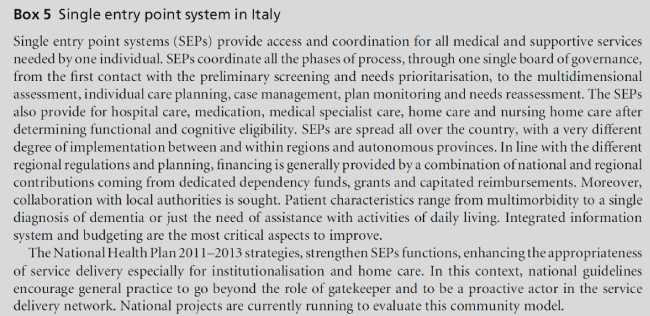
Box 5: Single entry point system in Italy
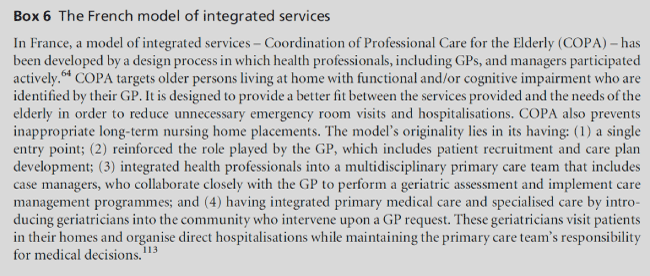
Box 6: The French model of integrated services
In the UK, case management methods[111] have been championed as a means of ensuring continuity of care,
improving patient outcomes and achieving efficient management of resources.[21,112] The core elements of any case management activity are: identification of individuals likely to benefit from case management; assessment of the individuals problems and need for services; care planning of activities and services to address the agreed needs; referral to and coordination of services and agencies to implement a care plan; and regular review, monitoring and consequent adap-tation of the care plan.
Community based care: providing care at home or within the community
Remaining at home or within the community seems to be a high priority for ageing individuals. Indeed, care should strive to help older persons to remain as active as possible and to receive services they need in their own environment.[114] Moreover, strong primary care also reduces the need for hospital care because it can provide care that previously had to be provided in a hospital setting and because it can prevent worsening of conditions by early intervention.[115] For example, in many countries, routine diagnosis and care for dia-betes patients has shifted from specialist to generalist care. However, some forms of care that are optimal in the community setting, like the geriatric assessments mentioned above, need specialist competences. In the Netherlands, some GPs are trained in geriatric assess-ments and geriatric medicine at large. Belgium has set up good collaboration between GPs and geriatricians through the ‘Belgian Care Program’ for geriatric patients. Geriatric day hospitals and external liaison in each hospital in Belgium transfer knowledge to the GP and his team and warrant continuity.[116] However, some
thresholds within this cooperation have been defined[117,118]
Primary care is unable to provide this without close collaboration with informal care and social services. However, policies and services that aim to promote older persons’ independence at home do not exist in all countries. In Serbia, for instance, informal care is the only resort and resource, without any support of community services. Pressure to create institutional care does exist – but only very few nursing homes provide shelter and care for older persons. By default then, there is heavy pressure for the promotion of independence.
In those countries that do actively promote inde-pendence, many struggle to lead different types of services to comprehensive care. Budgetary constraints are obvious, but collaboration between providers and continuity of care also suffer from competition be-tween providers and continuous sub-specialisation, for example, within nursing. In some countries, dif-ferent sources fund different care functions, which leads then to discontinuity and fragmentation. The search is on for (Funding) approaches and regulations that optimise comprehensive care.
Information, communication and technology (ICT) applications might support independence at home. A 2010 report ‘ICT & Ageing, European Study on Users, Markets and Technologies’ [119] provides an overview of policies and practice in European countries on the use of ICT and older persons, with a view of maintaining their independence, with numerous References to the role of primary care. One example is how local author-ities (e.g. in the UK, Germany, Belgium, Switzerland) encourage older and disabled people to rent com-munity alarms.[67] These are appreciated for raising confidence about being at home, both for patients and families, by knowing that help is at hand at all times.[120] Community alarms also help to delay institutional-isation, reduce admissions to hospitals, shorten hos-pital stays and reduce the duration of home attendant services.[121] Further adoption of technology will enhance independence of older persons and facilitate care provision.
Community based care: recognition of and support to informal care
Informal care is mostly delivered by relatives.[122] While providing informal care is a natural part of our rela-tionships and social capital in society, currently, there are different views in European countries on the role that informal care should play. As mentioned in previous sections, in southern European countries, informal care is much more regarded as the natural and preferred model of providing care, whereas in northern European countries older persons are entitled to home care that is provided by society. Both approaches, however, have their limits. Because rela-tives are unable to provide the informal care that is required, in some countries immigrant caregivers are increasingly being hired to care for older people (Box 7). Budget constraints and the lack of availability of personnel in northern European countries limit the support to home care that the health and social care system can provide and the demand for informal care is on the rise. While combinations of informal care and formal care – community nursing, for example – occur frequently, collaboration between informal and formal carers may be problematic in the sense of (lack of) respect, trust and coordination.[69] Older people who are caregivers may also be isolated and lonely. About one third of carers report feeling lonely at least sometimes.[42] Nevertheless, providing informal care often gives an important sense of meaning in the life of the caregiver. Primary care practitioners have a crucial position to monitor, detect and discuss the burden of care for caregivers and provide them the support necessary to optimise their role.
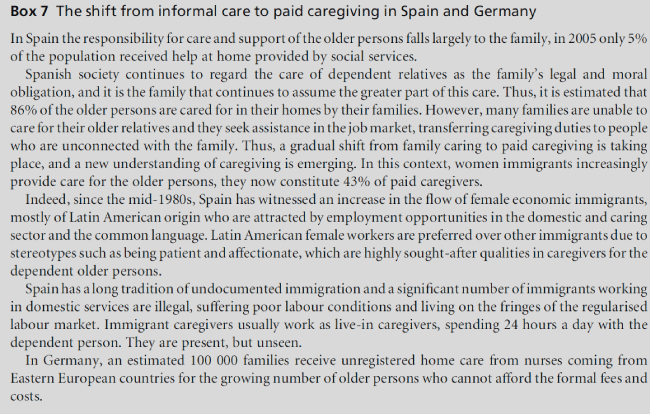
Box 7: The shift from informal care to paid caregiving in Spain and Germany
A proactive attitude of primary care practitioners is required if they are to adequately empower and assist their older patients. One of the key hallmarks of ageing is an increase in inter-individual variability, which means that clinical approaches need to be even more subtle and personalised than in younger people. Pro-viders should assess needs, offer preventative measures and guide their approach to goals that matter to patients as individuals. Primary care should provide comprehensive care and help patients to navigate through the health system. Where necessary, compre-hensive case management should be initiated, which integrates functional, physical, pharmacotherapeutic, mental, emotional and socio-economic information. Primary care should assist and promote remaining within the community or at home.
Organising primary care
Primary care teams and individual practitioners
Primary care has become multidisciplinary team-work,[123] for reasons of workload, expertise and skills. No professional alone can take responsibility for pro-viding the complex combination of services that deal with prevention, diseases, frailty and disability of their older patients. Progressively, GPs share their workload with other staff in primary care – community nurses, pharmacists, social workers – who may have their own relationship with, and information from, the patient. The introduction of new working methods (like case management) or new staff applying these new methods (community matrons) may disrupt existing com-munities of practice and be perceived in a negative light, at least in areas where good working relation-ships between nurses and GPs had developed pre-viously.
A single coordinator of care
Empirical and research evidence shows that the central medical professional for the care and management of (multiple) chronic diseases is the GP. This is related to their broad expertise but also to the usually longstand-ing relationship with older patients that ensures that the (medical) history of the person is taken into account.[124] Several studies demonstrate associations between physician–patient continuity and satisfaction,
reduced utilisation, increased efficiency and better preventive care.[125–127] The task of coordinating care is both clinical and oriented towards the process of care. However, practice and evidence suggest that GPs are not well positioned to do the full clinical coordi-nation[128] and that case management needs to be done by other professionals.
Community nurses or specialised nurses in primary care, like diabetes nurses, spend more time with the patient than the GP and frequently have a better over-view of the patient’s needs and expectations. The relationship between patient and GP is not so unique anymore and the GP needs to relinquish control and become a team player.[129,130] Obviously, this new role needs preparation, training and support.[131,132]
In several countries, case managers are being intro-duced: community nurses, social workers or other professionals who help the older patient/client to coordinate all the different services provided by a range of professionals. Their introduction follows different paths, with varying results, see boxes 8–11.
Coordination and continuity of primary and secondary care
The health condition of older persons when leaving hospital often is worse than when they entered. The better the coordination between primary and second-ary care, the shorter the average hospital stay.[137,140]
Discharge management should include an assessment of the living conditions, social environment and the risks that may jeopardise living (alone) at home. Geriatric departments are developing in hospitals across Europe.However, policy does not steer towards geriatric services in all suitable hospitals in all countries. In the UK, a recent evaluation of care for older persons shows the need for a new range of acute and rehabilitation services to bridge the gap between acute hospital and primary and community care. The aim of those services should be to promote faster recovery from illnesses, promote timely discharge, maximise rehabilitation opportunities and independent living.[142] Some GPs in the Netherlands do have ‘GP beds’, used for short-term observation and stabilisation of their mostly older patients, without specialist intervention.[143]
A basic condition of continuity of care, within primary care and between primary care, hospital or specialist care and other levels, is continuity of information. In many countries GPs or primary care groups do have patients on a list, mostly in electronic form. A single electronic patient file for all care providers does exist at local and regional level in several countries, but a national single electronic patient file does not exist as yet. In April 2011, the Dutch Parliament rejected legislation on this, mainly for reasons of safety of information. Similar issues do exist in other countries. For older patients, mostly one single local electronic file would be sufficient.
Policies in European countries strengthen primary care for older persons
Over recent years, many countries in Europe have developed a policy for health care for older persons in which care in the community provided by groups, or teams of professionals, plays a major role. However, progress is not equal and different policy bodies and organisations of providers and patients need to contribute and exert pressure. Boxes 10 and 11 show some of the variation in the development of care in the community.
Research and further developments
We have shown several areas in which understanding of needs and best approaches is lacking. Also, development of good practice has been mentioned. In particular, the following priorities emerged:
flat the population level, a thorough understanding of the impact of ageing is necessary to define the demands ageing will impose on the health system. Recognising patterns of disease and of needs and untangling concepts like multimorbidity, frailty, disability and social isolation should help to shape service delivery systems and justify the resources required. As social inequalities in health for older populations are poorly understood special groups should receive special attention.
flat the individual level, the boundaries of individual diseases should be crossed by defining patientcentred health outcomes such as QOL and degree of autonomy (related to disability and altered functional status), integrating contextual evidence and exploring and integrating the goals of the individual patient. Research in this field should adopt a bio-psychosocial viewpoint to health and will be interdisciplinary, looking at aspects of patients’ perspectives, goal setting, patient–provider communication and will mainly utilise qualitative research methods (e.g. in-depth interviews and focus groups).
• Providers in primary care need to be proactive and not wait for older patients to come forward with complaints. Prevention and health promotion at an older age are not to be forgotten. Further sharing of this good practice is a priority.
• There is a need to develop strategies for multimorbidity in clinical practice guidelines in primary care. Single disease approaches like DMPs have their benefits, but are insufficient. Outcomes should be adapted to the needs of each individual, who may prefer autonomy to longevity.
• The older patient will often transit between secondary and primary care. Howbest to organise that transition, resulting in seamless care, needs to be further studied in many countries.
• Geriatric assessment is a task for primary care, but specialist expertise in geriatrics in primary care is indispensable. How best to involve this expertise – which is not easily available in many countries – in the community is a much needed lesson to learn.
• The coordination of care for older persons by primary care is a pillar of primary care. Depending on context, the GP, nurse, case manager or matron may be the appropriate person to be the coordinator.
• The unequal adoption of modern technology suggests that there is much to gain with two-way communication between patient and providers in primary care. An important domain is the research into optimal provision of preventive services and home support, including ICT.
• Further development and testing of modularity – the combination of individualised care with standardised care at organisation level – is a promising concept in primary care.[70]
• Monitoring of quality and safety of healthcare needs indicators including primary care performance for older persons. Current EU-funded projects for the development of primary care and home healthcare indicators should be followed by further initiatives to collect data for comparison and ultimately quality improvement.[144,145]
The European Forum for Primary Care received Funding for the preparation of this Position Paper from the Belgian National Institute for Health and Disability Insurance (NIHDI).
Belgian National Institute for Health and Disability Insurance (NIHDI)
Commissioned; not externally Peer Reviewed.